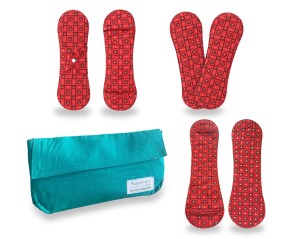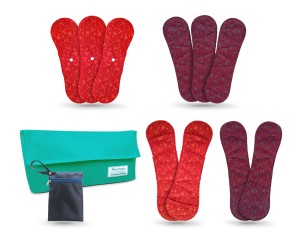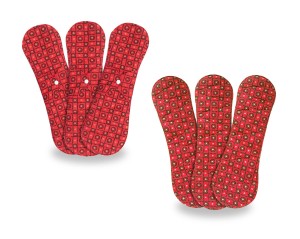FAQ
Switching to reusable pads is the choice many educated and well-informed girls and women are making today. All over the world, folks are becoming increasingly aware of the health risks and the environmental problems caused by disposable sanitary pads and are choosing reusable pads over disposable ones. Girls and women realize that it takes less time to wash a used pad as compared to shopping for disposable pads every month. Frankly, it has surprised us to see that large numbers of women making the switch. Many in their 20s, 30s and even 40s invest in a set of reusable pads. Our team conducts awareness sessions in schools, and it makes us really happy when teenagers choose reusable options over disposable pads. These smart youngsters understand that switching to reusable pads will ultimately help them save a lot of money as well.
Every year, an average woman will typically spend at least one thousand rupees if she is buying disposable pads. Saukhyam Reusable Pad sets that cost a fraction of this amount last for 1-2 years and help one realize considerable cost savings. The cumulative savings, if switching to reusable pads, would be in excess of several thousands of rupees when calculated over the entire menstruating lifetime.
Our menstrual blood is not a waste product like urine or feces. Because one did not conceive, the blood that would have otherwise been used to nourish a fetus is no longer needed in the body and is discarded. In many ancient cultures including the Indian culture, this blood was used to make fields more fertile. Menstrual blood is a source of micro-nutrients. There is research ongoing in international universities for isolating stem cells from menstrual blood that can be used for the treatment of diseases. Our used pads that are disposable smell awful but its not the menstrual blood that is the reason for that smell. For a healthy woman, the menstrual blood should not have any disgusting odor. Reusable pads do not smell and they are designed in such a way that they do not easily stain. Washing is easy; no extensive scrubbing is required. If washing was not an easy task that could be done within 5 minutes, we would not see so many making the switch. Try it. Most people do not report any problems with washing. If anything, they say that the ritual of washing has helped them better connect to their own bodies.
There are pad packs for adults and for teenagers. The primary difference between these two is the size. The teen size pads are petite and more suitable for use by teenagers. In addition, there are several options for those with heavy flow. The amount of banana fiber is different for the different pad types. All pad packs have sufficient number of pieces that offer adequate protection and a hygienic means to manage menstruation.
Many commercially available disposable pads use cellulose fiber (aka fluff pulp) for absorption. This is derived from trees and made in much the same manner as paper is made. We all know that using a lot of paper is harmful for the environment but we do not know that using a lot of disposable pads also is equally bad. To this cellulose fiber, SAP (super absorbent polymer) is usually added for increased absorption. This is a suspected carcinogen. Banana fiber is a naturally occurring material that is the absorbent in Saukhyam pads. It is also a type of cellulose fiber but with an important difference. The banana is the only tree that gives fruits only once. After the banana harvest is obtained, the tree is cut down. The fiber is extracted from the trunk of the cut-down tree and no trees are cut to extract cellulose fiber. Today, tons of banana trunks are discarded every year. Amma encouraged us to make use of banana fiber for reusable pads, after our testing process revealed that they help make the pads more absorbent, soft and durable. Our team has obtained a patent on these pads. There are other teams that use banana fiber as the absorbent, but for disposable pads.
Please see the video demonstrating the use of pads. The insert is tucked inside the base, which has a leak proof layer and wings that fold around your underwear and are secured with a button. Well-fitting underwear offers the best results.
Not at all. The soft cotton material that Saukhyam Reusable Pads are made out of enables free air flow that prevents the growth of anaerobic bacteria that can cause irritation and rashes. In fact, during a survey recently conducted, 70 out of 86 respondents said that with reusable pads they would experience rashes and after switching to Saukhyam, they now have no rashes at all. (The other 16 respondents did not experience rashes earlier and did not have rashes now as well).
There is a leak-proof layer in the bases for the banana fiber pads – both for the day and the night pads. This is made from PUL (poly urethane laminate) and is the same kind of fabric that umbrellas are made of. Many reusable pad brands worldwide have this leak-proof layer. Although some argue that this is plastic (and the buttons are plastic as well), we would like to remind that these pads are not single-use items. At the end of their lifetime, this layer can be taken apart and recycled.
A Saukhyam Reusable Pad can last 1-2 years, depending on the care it receives.
If you are ok with using pads that are slightly thicker, then the 3-fold pads are made especially for heavy bleeders. Otherwise, the day pad base and insert together is also adequate for most heavy bleeders. A set of 4 night pads is also available if these are preferred.
For the most part, reusable pads can be changed just as often as you would change a disposable pad. That is, every 4-5 hours, depending on how heavy your flow is. When using the day pad base and insert together, this double-decker pad is meant to last for more numbers of hours. The night pad also offers protection for several hours.
The liquid gets absorbed into the inner layers of the banana fiber. Some clots might stay on the surface. If the pad starts to feel wet, it just means that it is time to change to a fresh one. Regular users report feeling less wetness and more comfort with cloth against their body as compared to sticky plastic pads.
One can manage just fine. The soiled pads can be kept in the wet bag (available with the super pack) to be washed and dried when you reach your destination.
We suggest buying our ready-made packs to have enough pads to comfortably go through the monthly cycle. The super pack and the value pack are popular and should be adequate for most users, depending of course on your flow type.
The pads can be washed either by hand or in the washing machine. First, soak the soiled pads in cold water for about 5 minutes. Or rinse under a tap. After this, wash the pads just like you would wash any of your other clothes, either by hand or machine. Make sure you hang up the pads to dry in sunlight or use a dryer. Once washed and dried, the pad is ready for use again. It is perfectly ok to use an iron during the rainy season if the pads are taking a little longer to dry. Some women get creative and use their hair dryers as well to dry their pads.
You can use the wet bag (available with a super pack) to store soiled pads until they are ready to be washed. If you are not ok with the idea of folding a used pad and keeping it away for washing later, just hold it under a running tap for a minute or so and squeeze out all the blood. Then fold the wet but clean pad and keep it away for proper washing after returning home. Many who buy reusable pads at first use them only at home because they want to wash them immediately after use. However, several users who get used to the comfort offered by these pads figure out a way to use the pads at work or in school / college or even while traveling. On our team, almost all of us now are very comfortable using these pads even when we travel.
If one takes proper care of the reusable pad, then it is perfectly hygienic to keep reusing the pads. After soaking the soiled pad in cold water for about 5 minutes or so, wash it properly. Drying of the washed pad in direct sunlight will further help sanitize the pad and make it ready for reuse again. Alternately drying in a dryer is just fine too.
As part of Embracing the World’s Amrita SeRVe (Self Reliant Village) project to help 101 villages throughout India achieve empowerment and sustainability, rural women across India are trained in the production of the eco-friendly Saukhyam Reusable Pads for distribution and sales throughout the world.
Since its inception in 2013, Amrita SeRVe has supported its target communities in 20 states of India in successfully addressing a wide range of issues, ranging from literacy and food security to sustainable farming and empowering women. It is working in village clusters in the states of Andhra, Bihar, Chattisgarh, Gujarat, Haryana, Himachal Pradesh, Jammu and Kashmir, Jharkhand, Karnataka, Kerala, Madhya Pradesh, Maharashtra, Odhisa, Punjab, Rajasthan, Tamil Nadu, Telengana, Uttar Pradesh, Uttarakhand and West Bengal. Proceeds from the sales of Saukhyam Reusable Pads support various village developmental activities, including health and education programs for girls in the villages.
Yes, we conduct awareness sessions in schools, colleges and corporations. If you would like to schedule a session, please get in touch with us at info@saukhyampads.org.



